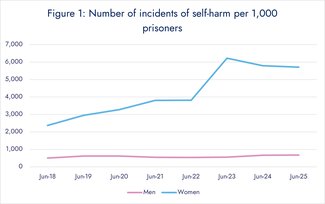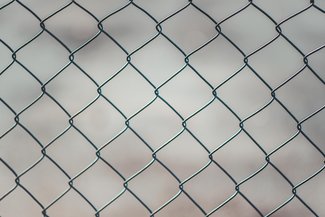
Agenda Alliance responds to the independent review into placement and care of girls in custody
We respond to Susannah Hancock's independent review into the placement and care of girls in custody.

31 Oct 2025
Yesterday, (30 October 2025), the Ministry of Justice published a quarterly update to its Safety in Custody statistics.
The update reveals:
Between June 2024 and June 2025:

Wider analysis: A spotlight on young women
The latest disaggregated data reveals that young women in custody are disproportionately affected by incidents of self-harm. In 2024:
'Yet again, the safety in custody statistics clearly demonstrate a consistent, worryingly high rate of women self-harming in prison.
These figures have become depressingly normalised, glazing over the reality that self-harm is a response to serious mental distress, with the prison system unequipped to deal with this, and, even worse, exacerbating this distress.
It is important to realise that behind these figures are over a thousand real women currently trapped in a prison system that is harming them. The women have either entered prison already suffering from acute mental illness and trauma, which the prison system is making worse, or they may have developed mental health conditions due to the harmful prison environment that is not designed with their needs in mind. The fact that repeated incidents are so high speaks to a chronic lack of support from the prison system.
The women need specialist, well-funded support in the community, not a custodial sentence. We know that women who have distinct needs (due to mental health, trauma, domestic abuse, and poverty, for example) that have been consistently overlooked, are criminalised. They have been let down by the very systems that are meant to protect them, and prisons add to this trauma. Prisons need to respond to these specific needs in a way that is age-, gender-, trauma-, and culturally-informed, rather than simply duplicating an approach that is designed for adult men.
This is especially the case for young women. Our previous research has shown that this age group demonstrate some of the highest levels of self-harm of any in prison, and the data confirms this. With such a high level of repeated self-harm amongst young women, we are seriously concerned for their safety and question the role of the prison service in upholding its duty of care.
The work of the Women’s Justice Board is well under way, with a particular commitment to tackling the acute challenges of young women in custody, including their levels of self-harm.
In its impending Young Women’s strategy, we need to see a clear, targeted, approach for young women in prison. This strategy needs to be cross-cutting, committed to overcoming silos, and supporting transitions from youth to adult estates, to ensure it meets the needs of those young women in custody. The strategy should also include approaches that help them to remain in their communities instead, supported by robust, specialist services designed to meet their specific needs.'

We respond to Susannah Hancock's independent review into the placement and care of girls in custody.

We are deeply concerned to see this inspection report detail troubling treatment of girls in custody, including using pain-inducing force and strip searches.

Our policy, research and campaigns manager Maisie reflects on some of the detail surrounding the new Suicide Prevention Strategy, how it relates to Agenda Alliance’s previous recommendations and research on women and girl’s suicidality and mental health, and the need for a joined-up approach.